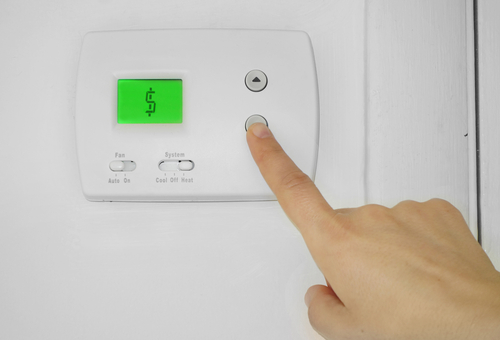As life outside gets greener, spring is also a good reminder of the importance of green practices in facilities. HVAC systems use 40-50% of a commercial building’s energy, translating to high energy usage and significant greenhouse gas emissions. However, this also presents ample opportunity to find efficiencies.

Balancing occupant comfort with sustainability is not always straightforward, especially in large industrial, manufacturing, entertainment, healthcare, and education facilities. But HVAC systems can be optimized to enhance efficiency without compromising a comfortable environment. Energy efficiency is a cost-effective solution, reducing environmental impacts and expenses simultaneously.
Here are a few simple, low-cost ways to be more energy efficient with HVAC systems.
1. Find and Seal Air Leaks
It should be a routine practice to find and seal air leaks so that the HVAC is not pumping away wasted energy. Considering HVAC fans use 60% of a building’s HVAC energy, reducing leaks, even by 15%, can dampen fan energy requirements up to 40%.
As facilities managers walk their buildings, they should listen for audible air leaks and teams should scan their systems with regularity using an ultrasonic leak detector. For HVAC systems, specifically, ultrasonic leak detectors may be the better tool (versus a thermal detector, for example) as they offer precision and sensitivity that other methods may lack. With ultrasonic leak detectors, you can hear the ultrasound of even tiny leaks.
2. Insulate Refrigerant Lines
Something as simple as tubular foam insulation around exposed copper refrigerant lines can reduce energy usage. Indoor lines that are insulated are 2% more energy efficient, and that figure doubles where lines are closer to the outdoors, such as attics and rooftops.
Benefits of insulating copper refrigerant lines include:
- Energy Efficiency: Proper insulation helps maintain the desired temperature of the refrigerant as it travels between the indoor and outdoor units. When refrigerant lines are well-insulated, they experience less heat exchange with the surrounding environment. This reduces energy losses and ensures that the system operates efficiently.
- Reduced Heat Gain/Loss: Insulation acts as a barrier, preventing heat gain during hot weather and heat loss during cold weather. Without insulation, copper lines can absorb heat from the surroundings or release heat, affecting the overall performance of the HVAC system.
- Preventing Condensation: Insulation minimizes condensation on the refrigerant lines. Moisture buildup can lead to corrosion of the copper tubing and degrade the insulation. Properly insulated line sets prevent condensation-related issues.
- Enhanced System Lifespan: Insulated line sets protect the copper tubing from external factors such as physical damage, chemicals, and moisture. Shielding the lines extends the lifespan of the HVAC system.
- Improved Indoor Air Quality: Insulation prevents mold and mildew growth within the line set insulation, which can negatively impact indoor air quality and system efficiency.
3. Replace Dirty Filters
Clogged or dirty air filters disrupt airflow, impairing an air-conditioning system’s efficiency. Additionally, dirty air that passes through the filter can be carried to the evaporator coils and reduce its ability to absorb heat and cool the building. According to the U.S. Department of Energy, clogged or dirty air filters may raise an HVAC unit’s electricity use by up to 15%.
With that in mind, be sure to include the following in routine maintenance tasks:
- Regularly replace filters. They should be changed once every three months or as recommended by the manufacturer. The following conditions indicate it’s time to change a filter:
- Differential Airflow Gauge. The differential airflow gauge measures the pressure drop across the air filter. As the filter accumulates dirt and debris, the drop in pressure increases. When the gauge indicates a significant pressure difference (>3psi), it’s time to check the filter.
- Signs of a Dirty Air Filter. A clogged filter restricts airflow, affecting the efficiency of your system. If there is visible dirt on the filter, it’s time for a replacement. A dirty filter forces the system to work harder, leading to higher energy bills.
- Keep Vents and Registers Clear. They should not be blocked by furniture, curtains or other objects; proper airflow helps maintain efficiency.
- Regularly Maintain HVAC Units. Regularly scheduled professional maintenance, including cleaning coils and checking refrigerant levels, help ensure optimal performance.
Installing an air filter whistle can help alert when it’s time to change heating and air conditioning filters.
Additionally, keep heat-generating equipment away from thermostats, like lamps, computers, and appliances. Also, switch to energy-efficient LED lighting to reduce heat load.
Managers of larger facilities should also be sure to check and manage temperature set points and ensure that systems, such as the Building Management System (BMS) or Building Automation System (BAS), are properly calibrated. These kinds of practices can lead to up to 30% in energy efficiency savings.
Another effective means to identify low- to no-cost energy-saving solutions is through Energy Treasure Hunts. These events, typically spanning two to three days, engage employees in energy conservation efforts across behavioral, operational, and maintenance actions. Energy Treasure Hunts provide valuable insights into building systems, including HVAC, uncovering energy-saving opportunities.

Gary Williams is the director of sustainability and energy solutions at ESFM, the corporate integrated facilities management division of Compass Group USA. He brings 25 years of combined experience in engineering and engineering management and has earned various industry credentials.
